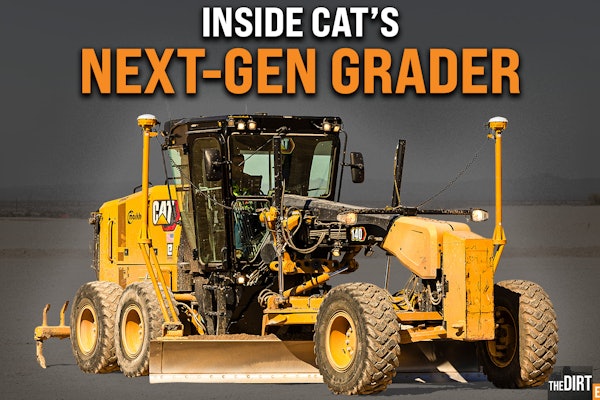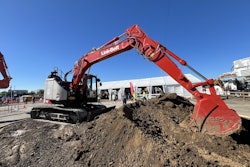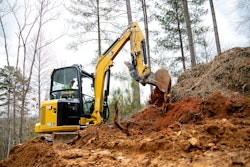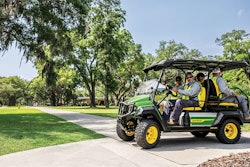Compact backhoe loaders with dig depths less than 8 feet generally weigh less than 5,000 pounds in work configurations. As such, they are turf-friendly and easy to transport – ideal for contractors engaged in light construction applications like site clearing, landscaping and residential utility work. Because they are physically small machines, they can work in backyards, between houses and around common urban obstacles that would seriously hamper the movements of larger equipment types.
“A compact backhoe, on top of its versatility, is also a heavy-duty excavating machine,” says Ken Paul, manager, compacts, Cub Cadet. “Backhoes in this class can do finesse work like dig holes for shrubs and trees, install utility lines or dig up stumps. They are fast, easy to use and precise.”
Compact backhoes compete to a certain degree with trenchers, skid-steer loaders and compact wheel loaders. Each machine type has specific strengths that make it ideal for different types of light construction applications; many of these strengths overlap between each machine type as well. The trick is to simply pay attention to your bread-and-butter applications and match machine performance accordingly. For compact backhoes, the emphasis will be on a combined need for fast load-and-carry cycle times, light attachment use and efficient digging capability.
Many contractors using machines in this size class typically dig in the 4- to 6-foot depth range. Any machine in this class meets that criteria, although you must be sure the arm crowd and bucket breakout forces are high enough to meet your production requirements when spec’ing a potential backhoe. Likewise, the front-end loader should have the lift capacity you need with pallet forks mounted, and have enough lift height to clear the sides of your loading bin or truck.
Compact backhoes can be used effectively in tandem with other types of construction equipment both large and small. “Some contractors use compact backhoe loaders with a skid steer or wheel loader when digging with the backhoe,” notes Keith Rohrbacker, product manager, Kubota Tractor. “Skid steers are your best choice for removing spoil in tight places. Compact wheel loaders are better in more open places, gathering up and preparing spoil for loading into trucks. Other contractors prefer to use a compact backhoe’s load-and-carry capability when trenching with compact excavators. There are many possibilities because these machines complement one another in many different ways.”
The ability to use Category I implements adds an extra dimension to a compact backhoe’s usefulness on a jobsite.
An added dimension for attachment use
Compact backhoes can handle limited attachment use. Bear in mind, Rohrbacker says, their small size tends to limit their available auxiliary hydraulic flow. So in some cases, they may not be the best machine to use with attachments powered by hydraulic motors.
Still, says Glenn Wright, product manager, compact equipment, John Deere, compact backhoes can effectively use many of the same attachments skid steers and other types of compact equipment do. “Savvy contractors have learned to use these tools on compact backhoes with great effect,” Wright says. “It’s an easy way to extend attachment use via these small machines and increase your jobsite productivity without incurring any additional costs. Of course, a front loader or backhoe quick coupler is an important feature to spec if you’ll be using attachments frequently.”
Many types of construction equipment can share and use attachments effectively. But compact backhoes have another productivity aspect that is not shared by skid steers, compact wheel loaders or other equipment types: Namely their ability to use PTO-powered implements as well.
“On many machines in this size class, the backhoe can quickly be removed from the main tractor frame,” Wright explains. “On a John Deere machine, it takes about two minutes to do.”
Once the backhoe has been removed, Wright notes the tractor’s three-point hitch and PTO drive are easily accessible. “At that point, you can mount and run any Category I implement off the rear PTO,” he adds. “This is a real plus for site prep and landscaping contractors because it adds hydraulically powered box blades, mowers, plows and a whole new array of implements to their attachment arsenal.”
Big machine features enhance performance and production
Even though compact backhoes are small, they are designed to work in exceedingly difficult applications. To do this, Rohrbacker recommends spec’ing a machine with an integral main frame. This unified design, he says, enables the backhoe loader to better withstand heavy-duty work or high-cycle applications while easing maintenance costs and downtime.
Kubota has begun using braceless loader frames on the front of its compact backhoes to improve visibility and access for serviceability, Rohrbacker adds. “We’ve also given these loader frames a sloped design that curves downward, matching the shape of the hood,” he says. “This also helps to improve visibility down and in front of the machine from the operator’s station.”
Other compact backhoe features have trickled down from larger backhoe designs. Among these are self-leveling loader control valves. Rohrbacker says this feature on Kubota machines improves the accuracy of pallet fork work, but can be easily disabled should you need to do loader work.
On the back end, some compact backhoes feature curved bottom boom structures. These curved booms can boost productivity in extensive truck-loading operations or when reaching over obstacles to dig or place spoil or dirt.
Hydrostatic transmissions are becoming more common on small backhoes, Wright says. “They’re almost impossible to kill when you’re digging in a pile or crossing sloppy terrain,” he says. “With Deere’s eHydro system, the transmission’s slosh plate automatically adjusts so the machine will stay as productive as it possibly can. If you enter into a pile of heavy material, the transmission is going to automatically provide the torque and horsepower you need so the machine doesn’t stall out. It’s a real boon for the inexperienced operators that many times get placed on these smaller machines.”










